WAGO Lighting protection
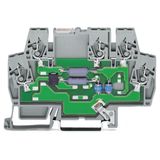
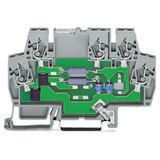
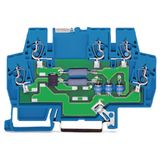


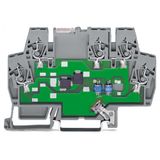
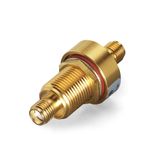
Lighting circuits, mast heads, and PV rooftops see fast transients and switching spikes. The goal is a repeatable kit: intake protection coordinated with sub-boards, point-of-use cartridges near LED drivers, and clean bonding so the whole path behaves the same on every project.
wago lighting protection solutions for mains and luminaires
Specify wago lighting protection at distribution boards feeding lighting rows and again at the luminaire, pole base, or canopy. The board stage absorbs energy and coordinates downstream; the point-of-use part trims residual voltage so drivers and control gear survive nearby strikes and utility events.
wago surge protection devices duties and placement
Modern wago surge protection devices follow the familiar stack: Type 1 at the service entrance, Type 2 in sub-distribution and MCCs, and Type 3 next to sensitive loads. Pluggable cartridges with status windows and remote contacts let maintenance teams swap spent modules and log alarms without opening every cubicle.
wago lightning arresters for service entrances and rooftops
Use wago lightning arresters at the intake or rooftop main LV board where partial lightning currents enter the system. These high-energy stages sit close to the main bonding bar, keeping leads short and upstream clearances simple while downstream devices retain selectivity.
wago overvoltage protection for data, control, and LED drivers
Signal paths and drivers need tailored clamps, and wago overvoltage protection covers 0–10 V, 4–20 mA, RS-485/Modbus, and Ethernet alongside compact AC/DC modules for LED power supplies. Look for low residual voltage and shield-friendly hardware so 360° terminations at gland plates remain neat.
wago electrical safety devices coordination and maintenance logic
To keep upstream breakers and contactors within limits, wago electrical safety devices publish let-through, backup fuse guidance, and short-circuit withstand. Thermal disconnects and flag indicators simplify rounds; dry contacts feed a BMS so replacements get planned, not discovered during outages.
wago grounding protection bonding, meshes, and tray practice
All surge work rests on bonding. wago grounding protection assumes short, wide conductors to the PE bar, regular bonding meshes in long corridors, and shield clamps that terminate 360° at the entry plate. Bond cable trays, keep bends gentle, and route SPD leads away from sensitive I/O.
wago surge protectors compact formats for panels and poles
Space is tight in columns and pole bases, so wago surge protectors arrive as slim DIN modules for boards and rugged cartridges for outdoor heads. Choose replaceable designs with moisture-tolerant housings; status windows and keyed plugs make night shift checks fast.
Product families and series overview
- Intake stages Type 1 or Type 1+2 rail modules for TN/TT/IT systems; replaceable MOV/combination elements with remote signaling.
- Sub-boards and machinery narrow Type 2 modules sized to feeder exposure; coordination data provided for selective designs.
- Point-of-use near drivers Type 3 modules beside LED gear, controls, and small transformers; low residual voltage to protect electronics.
- Signal and data lines in-line protectors for analogue loops, RJ45-ready parts for Ethernet, and RS-485 clamps with minimal insertion loss.
- Outdoor lighting pole-base and luminaire-head cartridges with quick disconnects and sealed construction.
- PV arrays DC string protectors for combiner boxes and inverter inputs with clear polarity and earthing guidance.
Technical specifications and standards that matter
Select by continuous operating voltage (Uc), protection level (Up), nominal discharge (In), and—for intake stages—high-energy wave handling; confirm short-circuit withstand and required backup device. Keep total lead length (phase plus PE) short to limit added voltage. For data protectors, check bandwidth, capacitance, and shield termination hardware. IP ratings and swap methods matter outdoors; in panels, choose footprints that match your rail spacing and labeling system.
Applications and compatibility
- Commercial interiors sub-board Type 2 plus point-of-use trims at LED drivers; Ethernet clamps at floor switches for PoE stability.
- Industrial bays MCCs with coordinated Type 2, analogue/encoder line clamps near drives, bonded trays to stabilise EMC.
- Street and area lighting pole-base cartridges with quick status checks; second stage in the head for harsh corridors.
- PV rooftops and yards DC string protection in combiners, AC protection at inverter output, short bonds to the array PE.
Integration with other WAGO products
Mount protectors beside TOPJOB® S terminal rows to keep leads short and labeled; use WAGO shield clamps for 360° bonds; land remote contacts on WAGO I/O for alarms; match gland threads and rail accessories already used in your panel standard so spares remain unified.
Selection criteria for B2B clients
- Earthing system decide TN/TT/IT first; it drives the intake module choice.
- Energy profile pick Type 1/1+2/2/3 per board level and exposure, then confirm coordination.
- Backup and Ik verify the upstream device, prospective fault current, and any fuse/MCB requirements.
- Signals and networks specify interface, bandwidth, and shielding method; document 360° termination.
- Service model prefer pluggable cartridges and remote contacts where access is difficult; standardize label plates for fast swaps.
Advantages of working with Bankoflamps
Procurement is set up for engineering teams: you receive project-specific B2B pricing with tailored offers, handled by a named account manager who knows your BOM. Quotes typically return in about an hour, and ordering by EAN or MPN keeps documentation aligned. The portal shows real-time EU stock with lead-time and order-status tracking; current price lists are downloadable, and purchase history with analytics supports repeat builds. Established customers can operate on post-payment terms up to 30 days. We consolidate consignments to reduce delivery costs, hold prices with stated validity windows, and actively supply partners in France, the Baltics, Germany, Spain, Italy, Belgium, and the Netherlands.